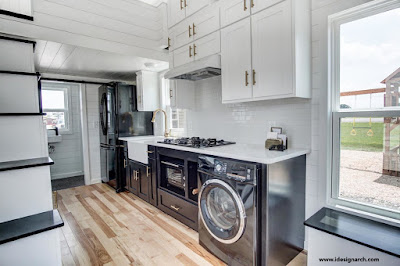Language:
The Tiny Home Trend: Think big, build small
Blog 11/01/2018

The (big) small homes trend is everywhere these days. You might have caught a glimpse of this trend on TV shows like “Tiny House Nation” on FYI and HGTV’s “Tiny House Hunters”. Fans who subscribe to this trend talk about it being a social movement, where people chose to downsize in order to live a simpler life in a smaller and more efficient space.
Small homes come in a variety of forms. While most are less than 1,000 square feet in size, miniature conventional houses, or “tiny homes” as they are usually referred to, are generally 120 square feet. Some are built on a permanent foundation using traditional materials, while others are constructed on wheels so that they can be easily transported for a truly mobile home. The possibilities for tiny home living are endless!
Small homes can also provide a solution for major urban centres to address their housing issues. For example, to accommodate increased demand for housing while struggling with urban density, Vancouver’s city planners encouraged a pilot project initiative, inciting the construction of houses between 280 and 900 square feet in unused laneways and backyard areas. The pilot project has been so popular that the city of Vancouver recently approved plans to build 4,000 new laneway homes over the next 10 years.
With the rising cost of traditional home ownership and rental units, it is also perhaps no surprise that smaller homes have become so appealing. Whether people are looking for a new home in an urban center or in a remote location, small homes offer a great solution. This type of living is often closely associated with minimalism, another growing trend, particularly among younger generations, as more people want to decrease their ecological footprint.
Advantages of choosing a tiny home
- Less impact on the environment than a traditional house
- Less building materials are required
- Energy and heating systems are more efficient, saving money
- Mobile tiny homes can be moved into the shade during summer and under the sun during winter to take advantage of seasonal temperatures
- Less clutter – embracing the minimalist lifestyle means you can finally clean out the basement!
- Save time on home maintenance and repairs
Things to consider
- Costs. Special requirements like access to land to build your tiny house on and possible custom-made furniture to accommodate its size.
- Mortgage. Mobile tiny homes can be considered a trailer and therefore, do not qualify for a mortgage.
- Appreciation. As they generally do not increase in value over time, tiny homes are not considered an investment in the same way that a traditional house is.
Downsizing from a traditional house to a tiny home presents other challenges too. For instance, conventional methods for building, plumbing and other systems may not be possible. When it comes to non-traditional plumbing applications, Saniflo® offers smart solutions for tiny home owners and builders. The company manufacturers above floor plumbing systems which are installed with minimal construction and can be used to plumb an entire space with multiple connections, such as a toilet, sink and shower. Its Sanicompact®, for instance, is a complete macerating toilet and pumping system that features a compact, tankless design, making it a great choice for tight spaces. It is also eco-friendly and saves money by using much less water than a traditional toilet.
Saniflo offers a range of macerating and grinding products as well as grey water pumping systems – all of which utilize their unique, above floor installation and upflush technology. Saniflo is a perfect solution for a tiny homeowner looking to install a kitchen, bathroom or laundry.
Live in a tiny home? We want to hear from you! Connect with us on Facebook or call us at 1-800-363-5874.

